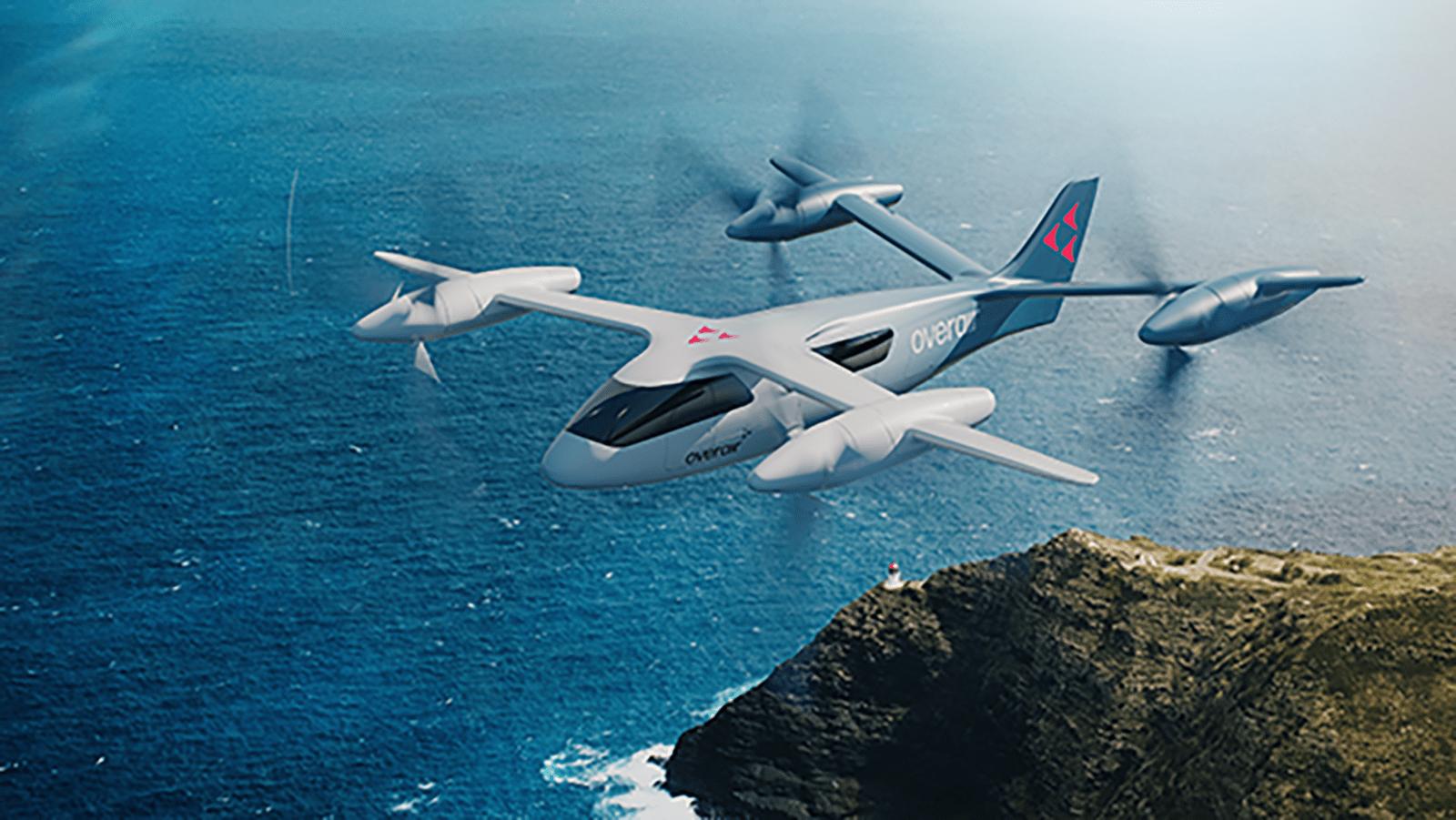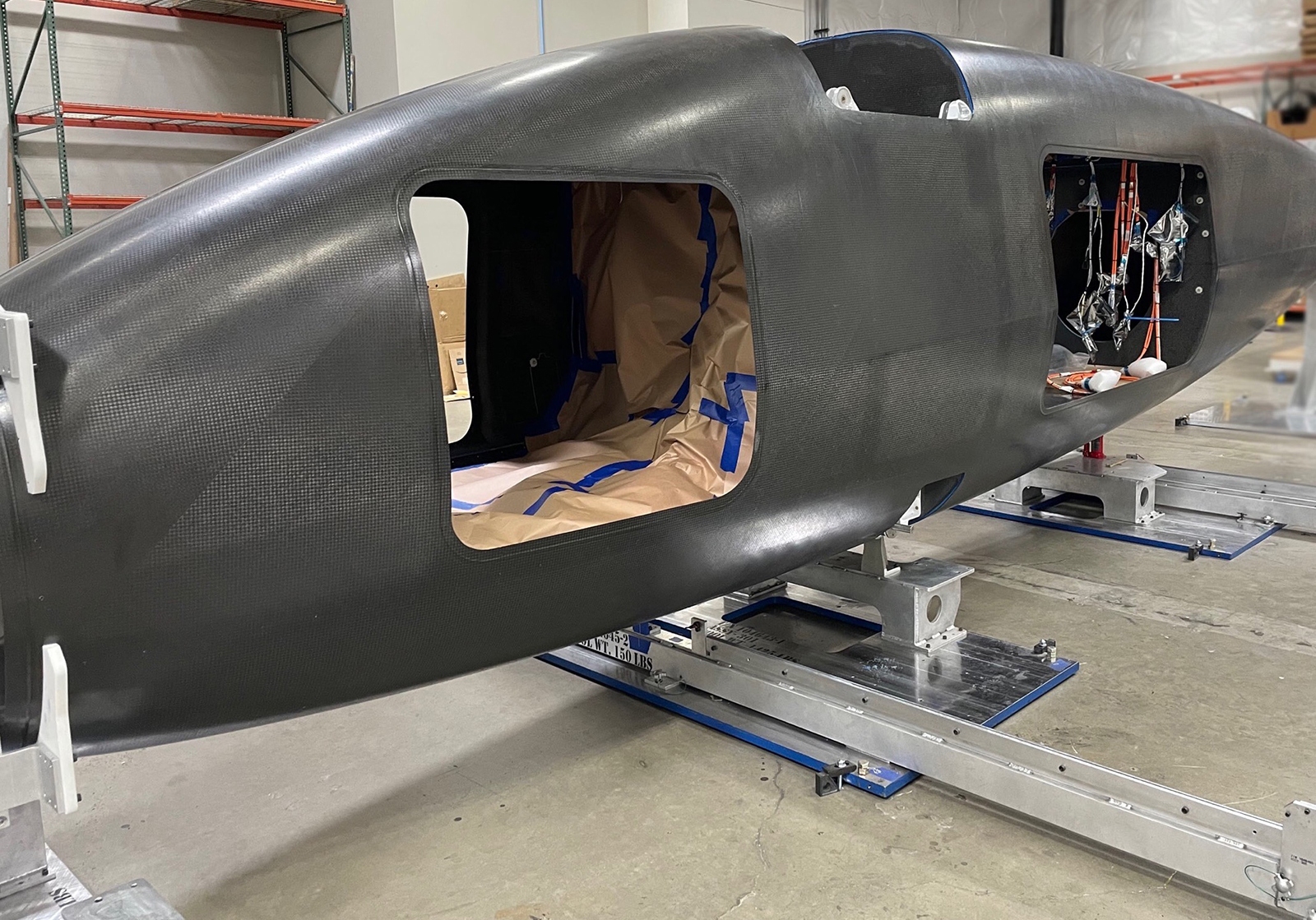Stay Up to Date
Submit your email address to receive the latest industry and Aerospace America news.
Company touts its large rotor design as quietest in the industry
The description of the propulsion technology in this story has been updated.
SANTA ANA, Calif. — Inside two white industrial buildings south of Los Angeles, advanced air mobility startup Overair is busily assembling carbon fiber composite prototypes for its vertical lift aircraft, the Butterfly tiltrotor air taxi.
The private company, not needing to promote itself for the stock market, has been relatively quiet about its progress compared to the bigger competitors also based in California: Joby Aviation, Archer Aviation and Wisk Aero.
Now, Overair co-founder and CEO Ben Tigner, who was once president of the pioneering drone company Karem Aircraft, is ready to show me the almost fully assembled fuselage of the first prototype, as he explains why he believes Overair’s rotor design — he says they will be the largest in the air taxi industry — and its proprietary technology will lead the company to success.
Tigner guides me around the facility. There are offices, an aircraft integration and testing area, a carbon fiber composite fabrication room, an autoclave, a chamber where automated routers trim aircraft parts, a machine shop and a wire harness assembly shop, plus laboratories to test parts, batteries and electronics.
The company has 170 employees, and although not all are on site, the main building is bustling with activity and the sounds of manufacturing. A secondary building is still mostly empty, as Overair anticipates expansion. Together, the buildings comprise 18,850 square meters, equivalent to a little over three American football fields.
First, Tigner shows me a full-scale model of a rotor six meters across and a small-scale model of the Butterfly. Since the aircraft’s rotors are so large, it only needs four, the company says.
Tigner notes that number compares to six rotors for Joby, 12 for Archer and 18 for Germany-based Volocopter’s VoloCity air taxi. He acknowledges that multiple rotors can be an advantage in case one fails, but Tigner says each Butterfly motor has multiple controllers and components that mean it would only lose portions of its propulsion in the event of a component failure.
The company’s secret, he says, is based on a combination of slow-turning propellers, whose blades are controlled very precisely, and the method Overair uses to make its carbon fiber composite rotors large, strong, and lightweight.
Performance attributes for such a large rotor are “far superior and allow you to be much quieter than other vehicles because there’s lower tip speed,” he says. “We’re able to push large amounts of air more gently. That makes us more efficient in terms of hover. We can hover this airplane using less power than others could for an equivalent payload.”
He declines to tell me at what speed the rotors move, but says it’s half the speed of a large helicopter, where tip speed can be 240 meters per second.
The proprietary technology dates back 20 years to Karem Aircraft and its founder, Abraham Karem, widely considered to be the father of drones. “As we developed the technology at Karem, we realized it could apply to an Uber-like service in an air taxi, and that’s what led to the founding of Overair” in 2019, Tigner says. “So even though we’re a reasonably new company, we are using technology that has been developed and matured over a long period of time.”
Next, we enter the carbon fiber composite fabrication shop. Stored around the chamber are wings, nacelles and other parts. In the back, I see the long black fuselage. Wires and cable are visible through openings, and three technicians are lying underneath it as they work. Doors aren’t attached yet.
“This is close to being completed. It consists of a left half and a right half with an internal structure for sealing bulkheads,” Tigner says. The company is aiming for that fuselage to fly, remotely piloted, in early 2024 at its flight test facility in Victorville, a 90-minute drive from the Santa Ana headquarters.
Butterfly’s propulsion and design will seat five passengers and a pilot, who will be walled off from the passenger cabin for security, Tigner says. He points out that many air taxi developers are planning for three to four passengers.
“Our airplane is quite modular. It is shippable in 40-foot [12 meter] cargo containers and fairly easy to bolt together, which is a major advantage,” he says.
As we walk through the machine shop, technicians monitor and control milling machines and CNC [computer numerical controlled] machines. Tigner says many of the parts being made are for “bird two” — the company’s second prototype.
He also shows me the System Integration Lab, where two workers monitor screens as banks of computers run simulations of the aircraft and its systems.
One of our last stops is in the secondary building, where Overair tests its lithium-ion batteries in a cargo container positioned at a loading dock. The metal doors to the container are open, but a see-through plastic strip curtain hangs at the entrance, which allows employees to exit the container quickly in case of a fire, slamming the metal doors shut, Tigner says.
As the tour concludes, he emphasizes the quiet nature of Butterfly’s rotors again. He says the stability of the rotors also will make Butterfly the smoothest ride during transition from vertical flight to forward horizontal cruise.
“Low noise levels and comfort will be crucial to public acceptance,” he says.
About paul brinkmann
Paul covers advanced air mobility, space launches and more for our website and the quarterly magazine. Paul joined us in 2022 and is based near Kennedy Space Center in Florida. He previously covered aerospace for United Press International and the Orlando Sentinel.
Related Posts
Stay Up to Date
Submit your email address to receive the latest industry and Aerospace America news.





